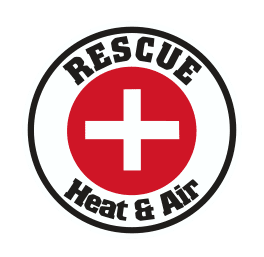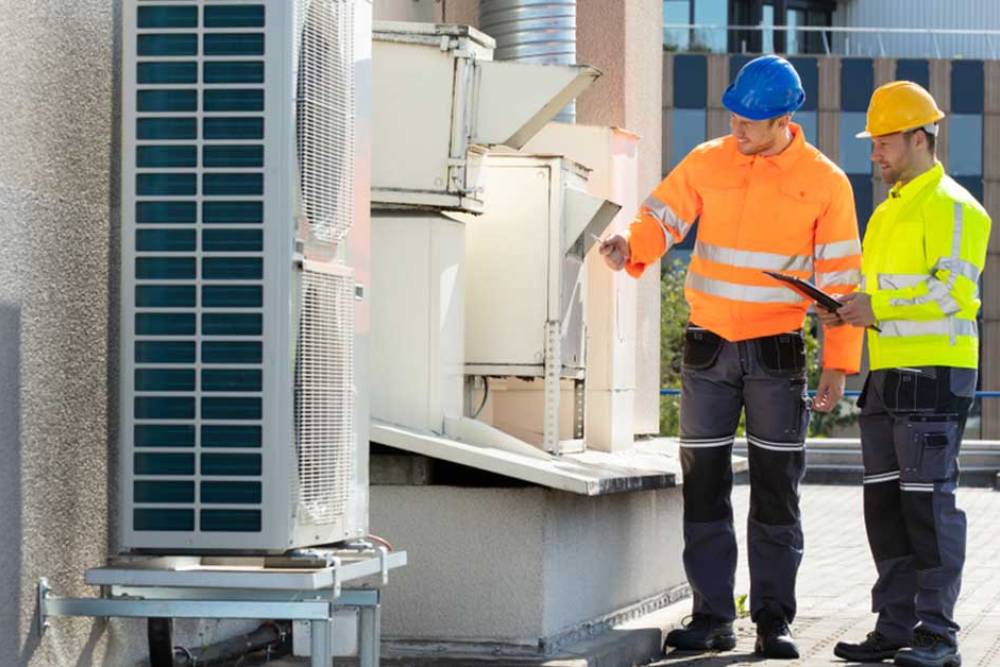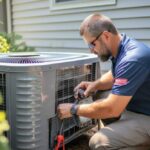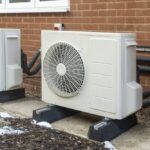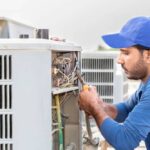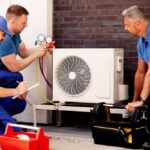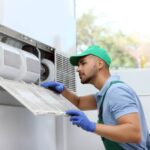Table of Contents
When your commercial HVAC system starts showing signs of wear, the big question is: should you repair or replace? While repairs might seem like the more affordable option upfront, they could cost your business far more in the long run — in money, energy use, comfort, and productivity.
At Rescue Heat & Air, we’ve helped countless Oklahoma businesses make the right call for their HVAC systems. In this guide, we’ll break down the true cost of commercial HVAC repairs vs. full replacement, so you can make an informed decision.

7 Key Factors to Weigh Before Choosing HVAC Repair or Replacement
Deciding whether to repair or replace your commercial HVAC system isn’t always straightforward. Before making a costly decision, it’s essential to consider several key factors that can impact your bottom line, energy efficiency, and long-term comfort. Here are seven crucial points to help guide your choice.
1. Initial Cost Comparison: Repairs vs. Replacement
- Repairs: Minor fixes (like belts, capacitors, or filters) may only cost a few hundred dollars. But major repairs like compressor or coil replacement can run into the thousands.
- Replacement: A new commercial HVAC unit typically costs between $5,000 and $50,000+, depending on system size, building requirements, and energy efficiency features.
Pro Tip: If a single repair costs 50% or more of the system’s value, replacement is often the better long-term investment.
2. Energy Efficiency: How Old Systems Cost You Monthly
Older systems, especially those over 15 years, are far less efficient than modern units. Even with repairs, an outdated unit may be driving up your utility bills.
- A new, energy-efficient HVAC system (rated SEER 14+ or ENERGY STAR) can lower monthly energy costs by 20–40%.
- Repeated repairs can’t improve efficiency — they only delay the inevitable.
Savings Insight: Upgrading an inefficient 10-ton HVAC unit could save your business $1,200–$2,500/year on energy alone.
3. Downtime Costs & Business Disruptions
Every hour your HVAC system fails is time your business suffers:
- Uncomfortable employees = reduced productivity.
- Loss of temperature-sensitive products (like food, electronics, or medications).
- Unhappy customers in retail or hospitality settings.
Repair Risks: Emergency repairs take time — parts may need to be ordered, and issues can resurface.
Replacement Advantage: A new system ensures consistent performance, especially during Oklahoma’s extreme heat or cold.
4. Maintenance Frequency & Costs
A unit requiring frequent repairs is a red flag. Ask yourself:
- Are you calling a technician more than twice a year for repairs?
- Have your maintenance costs been increasing steadily?
While maintenance plans are essential, chronic repairs eat into your budget. Replacing the unit may offer more predictable costs and fewer service disruptions.
5. Hidden Costs of an Aging System
Old systems don’t just cost more in energy and repairs. They may:
- Struggle to maintain indoor air quality.
- Lead to uneven heating/cooling (hot/cold spots).
- Leak refrigerants (which can be expensive or phased out, like R-22).
You’re likely paying more than you realize in long-term losses tied to performance and comfort.
6. Financing & Tax Incentives for New HVAC Systems
Replacing your HVAC system might feel like a big financial leap — but many Oklahoma business owners are eligible for:
- Section 17G deductions (write off new equipment purchases).
- Energy efficiency rebates or utility incentives.
- Low-interest commercial HVAC financing options.
Ask us about current 2025 rebates and tax credits for energy-efficient upgrades.
7. When Repairs Make Sense
Not every situation calls for replacement. Repair may be the smarter option if:
- Your system is less than 10 years old.
- The issue is minor and isolated.
- You’ve had minimal repairs in the past.
Our technicians always perform a thorough inspection and give honest recommendations — no upselling.
HVAC Repairs vs. Replacement: Decision-Making Checklist for Business Owners
Use this checklist to evaluate whether repairing or replacing your commercial HVAC system is the smarter choice for your business.
When to Consider HVAC Repairs
- The system is under 10 years old.
- Repair costs are under 30% of the cost of a new unit.
- HVAC has had minimal breakdowns in the past 2 years.
- You’ve kept up with annual maintenance and tune-ups.
- Energy bills have remained stable, with no major spikes.
- Your building’s cooling/heating needs haven’t changed.
- Replacement parts are readily available.
- Indoor comfort is not compromised (temperature, humidity, air quality).
- Your business can’t afford extended downtime for installation right now.
When It’s Time to Replace Your HVAC System
- The system is older than 12–15 years.
- Repair estimates are over 40–50% of replacement cost.
- HVAC unit requires frequent service calls or breaks down often.
- Monthly utility bills are increasing steadily.
- It uses outdated refrigerants like R-22 (no longer EPA compliant).
- Inconsistent temperatures or airflow throughout your facility.
- Business operations are expanding, increasing cooling/heating demand.
- You want to benefit from new energy-efficient technologies.
- You’re planning a renovation or interior system upgrade soon.
- The HVAC system fails to meet indoor air quality standards for employees/customers.
Pro Tip from Rescue Heat & Air:
Still unsure? Ask our team for a cost-benefit analysis. We’ll evaluate your system’s condition, energy usage, and building requirements to help you make a confident, cost- effective decision.
Get Expert Guidance from Oklahoma’s Trusted Commercial HVAC Pros
At Rescue Heat & Air, we don’t believe in one-size-fits-all advice. Our licensed commercial HVAC technicians will assess your system and help you weigh the true costs — not just the upfront price. Call us today at (918) 946-6681 or request a commercial HVAC assessment.
